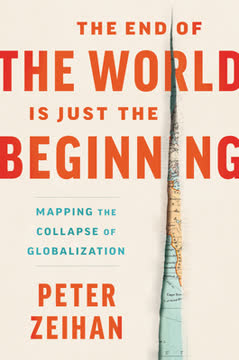Key Takeaways
1. Strategic Thinking: Align Goals, Embrace Change, Communicate Clearly, Decide Promptly
There is nothing so useless as doing efficiently that which should not be done at all.
Strategic foundation. Effective leadership begins with strategic thinking, which involves aligning team and individual goals with the organization's overall objectives. This requires a clear understanding of the big picture and the ability to adapt to change. Leaders must also communicate their vision effectively and make prompt decisions.
Key components of strategic thinking:
- Setting clear, measurable goals that support the organization's mission
- Embracing innovation and adaptability to stay ahead of the curve
- Communicating the mission, vision, and expectations clearly to the team
- Making prompt and effective decisions to keep the team moving forward
Strategic thinking is not a one-time event. It's an ongoing process that requires constant evaluation and adjustment. Leaders must be willing to challenge the status quo and embrace new ideas to ensure their organizations remain competitive and relevant.
2. Team Focus: Build Culture, Drive Performance, Motivate, Grow
You’ll also need to regularly reevaluate your progress to ensure you’re on the right path.
Team-centric approach. Effective leaders understand that their success is directly tied to the success of their teams. This requires building an open and collaborative team culture, driving performance through clear expectations and accountability, motivating team members through engagement and recognition, and fostering continuous growth and development.
Key elements of team focus:
- Creating a culture of open communication, trust, and respect
- Setting clear performance expectations and holding team members accountable
- Motivating team members through engagement, recognition, and empowerment
- Providing opportunities for continuous growth and development
Team focus is not about coddling. It's about creating an environment where team members feel valued, supported, and challenged to reach their full potential. This requires a commitment to both individual and team growth.
3. Tactical Work: Value Time, Master Technology, Maximize Agility, Sustain Balance
Leaders manage time most productively at the intersection of effectiveness and efficiency.
Tactical execution. Effective leaders must also be skilled at tactical execution, which involves valuing their time and maximizing their personal impact. This requires mastering technology to streamline workflow, maximizing agility to respond quickly to change, and sustaining personal balance to maintain physical and mental health.
Key aspects of tactical work:
- Valuing time and focusing on high-impact activities
- Mastering technology to streamline workflow and data handling
- Maximizing agility to respond quickly to change and unexpected situations
- Sustaining personal balance to maintain physical and mental health
Tactical work is not about busywork. It's about focusing on the activities that produce the greatest results while minimizing wasted time and effort. This requires a commitment to both personal and team productivity.
4. The Executive's Role: Execute Effectively and Efficiently
In reality, an executive is someone who executes—almost anyone with the authority to make significant decisions and whose time is spent producing value and/or managing people for the benefit of the organization.
Beyond titles. An executive is not just a title; it's a role defined by the ability to execute effectively and efficiently. This means making sound decisions, taking action, and producing results. It's about managing time, resources, and people to achieve organizational goals.
Key responsibilities of an executive:
- Making sound decisions based on available information
- Taking action and executing strategies promptly
- Producing value for the organization
- Managing people and resources effectively
Executives are not just managers. They are leaders who inspire and empower their teams to achieve great things. They are also responsible for their own productivity and must be able to manage their time and energy effectively.
5. The 3T Leadership Model: Think, Team, Tactics
The 3Ts are the chief time management roles for leaders: Strategic Thinking, Team Focus, and Tactical Work.
Three core roles. The 3T Leadership Model provides a framework for understanding the different roles that leaders play: Strategic Thinking (THINK), Team Focus (TEAM), and Tactical Work (TACTICS). These three roles represent the key areas where leaders spend their time and energy.
The 3T Leadership Model:
- THINK: Acting as the organizational strategist who focuses on business goals
- TEAM: Serving as the conscientious leader who focuses on employee productivity
- TACTICS: Being the productive performer who focuses on task completion
The 3Ts are not mutually exclusive. Effective leaders must be able to balance all three roles, shifting their focus as needed to meet the demands of the situation. The model provides a framework for understanding how leaders can manage their time and energy most effectively.
6. The Importance of Alignment: Strategy, Team, and Personal Goals
Your personal and team goals should always contribute to or support the organization’s overall goals.
Unified direction. Alignment is crucial for organizational success. This means ensuring that individual and team goals are aligned with the organization's overall strategic objectives. When everyone is working toward the same goals, it creates a sense of unity and purpose.
Achieving alignment:
- Start with the organization's core values, mission, and vision
- Communicate the organization's goals clearly to all team members
- Help team members understand how their work contributes to the overall goals
- Encourage team members to take ownership of their goals
Alignment is not about conformity. It's about creating a shared understanding of the organization's direction and empowering team members to contribute their unique talents and perspectives.
7. The Power of Communication: Mission, Vision, and Ideas
Effective communication sets profitable, productive organizations apart from the duds.
Clear and concise. Effective communication is essential for organizational success. This involves conveying the organization's mission and vision clearly, promoting new ideas effectively, and creating a cohesive team environment. Leaders must be able to communicate in a way that is both simple and straightforward.
Key elements of effective communication:
- Communicating the organization's mission in clear and concise terms
- Promoting the vision to peers and upper management effectively
- Creating cohesion and presenting a united front when selling new initiatives
- Using multiple communication methods to reach all team members
Communication is not just about talking. It's about listening, understanding, and responding to the needs of others. It's also about creating a culture of open and honest dialogue.
8. The Need for Decisive Action: Resolve and Execute
You make a decision even when you refuse to act, but that’s no better than depending on a coin toss.
Action over analysis. Effective leaders are not afraid to make decisions and take action. They understand that indecision can be just as damaging as a wrong decision. Once a decision has been made, it's important to execute it promptly and efficiently.
Key aspects of decisive action:
- Resolving indecision quickly and avoiding procrastination
- Collaborating with team members to make informed decisions
- Executing decisions promptly and efficiently
- Being willing to reverse course if necessary
Decisive action is not about recklessness. It's about making informed decisions based on available information and taking action to move the organization forward. It's also about being willing to learn from mistakes and adjust course as needed.
9. The Value of Team Culture: Openness, Receptiveness, Risk-Taking
You’ll also need to regularly reevaluate your progress to ensure you’re on the right path.
Culture of innovation. A positive team culture is essential for fostering innovation and productivity. This involves creating an environment of openness, receptiveness, and risk-taking. Leaders must encourage team members to challenge the status quo and embrace new ideas.
Key elements of a positive team culture:
- Creating a culture of team efficiency by simplifying workflow and improving processes
- Encouraging team receptiveness toward urgency, nimbleness, and swift execution
- Rewarding risk-taking and challenging team members to think creatively
- Promoting a culture of continuous improvement and learning
Team culture is not about being nice. It's about creating an environment where team members feel safe to take risks, share ideas, and challenge each other to be better.
10. The Focus on Results: Substance over Style
What matters is this: can you and your team consistently produce at a high level, meeting or exceeding your goals before reaching out for new ones?
Results-oriented approach. Effective leaders understand that results matter more than style. This means focusing on substance over superficiality and prioritizing activities that produce tangible outcomes. It's about achieving goals and making a positive impact on the organization.
Key aspects of a results-oriented approach:
- Emphasizing substance over style and focusing on what truly matters
- Setting clear performance expectations and holding team members accountable
- Measuring results and providing meaningful feedback
- Celebrating successes and learning from failures
Results are not just about numbers. They are about making a difference and creating value for the organization. It's about focusing on the activities that produce the greatest impact.
11. The Importance of Continuous Improvement: Growth and Learning
Continuous improvement has its flaws if applied to the wrong teams the wrong way, because too-rapid change can stifle ideas before they mature into usefulness.
Growth mindset. Effective leaders understand that continuous improvement is essential for long-term success. This involves stretching team members' abilities, emphasizing accountability, and encouraging healthy conflict. It's about creating a culture of learning and growth.
Key elements of continuous improvement:
- Stretching team members' abilities by encouraging them to grow
- Emphasizing accountability and expecting team members to take responsibility
- Encouraging healthy conflict and debate
- Providing opportunities for continuous learning and development
Continuous improvement is not about perfection. It's about making progress and striving to be better each day. It's about creating a culture of learning and growth where team members are constantly challenged to reach their full potential.
12. The Necessity of Self-Care: Physical and Mental Health
You can’t be like dandelion fluff, going wherever the wind takes you.
Personal well-being. Effective leaders understand that their personal well-being is essential for their long-term success. This involves practicing self-care, maintaining physical health, and sharpening mental acuity. It's about creating a sustainable lifestyle that supports both personal and professional goals.
Key aspects of self-care:
- Practicing personal self-care and relaxation on a regular basis
- Maintaining physical health through diet, exercise, and sleep
- Sharpening mental acuity through learning and reflection
- Setting boundaries and prioritizing personal time
Self-care is not selfish. It's about taking care of yourself so you can be more effective in all areas of your life. It's about creating a sustainable lifestyle that supports both personal and professional goals.
Last updated:
FAQ
What's "Doing the Right Things Right" about?
- Focus on Productivity: The book by Laura Stack is centered on enhancing productivity by combining effectiveness (doing the right things) with efficiency (doing things right).
- Leadership and Management: It provides insights into how leaders can manage their time and resources to achieve maximum results in minimum time.
- 3T Leadership Model: The book introduces the 3T Leadership Model, which includes Strategic Thinking, Team Focus, and Tactical Work, as a framework for effective leadership.
- Practical Advice: It offers practical strategies and tools for leaders to improve their personal and organizational productivity.
Why should I read "Doing the Right Things Right"?
- Improve Productivity: The book provides actionable strategies to enhance both personal and team productivity.
- Leadership Development: It is a valuable resource for leaders looking to refine their management skills and lead more effectively.
- Time Management: Offers insights into managing time efficiently, which is crucial for achieving business goals.
- Real-World Examples: The book includes real-world examples and testimonials from business leaders, making the advice relatable and applicable.
What are the key takeaways of "Doing the Right Things Right"?
- Effectiveness and Efficiency: The importance of balancing doing the right things with doing things right to maximize productivity.
- 3T Leadership Model: Understanding and applying the Strategic Thinking, Team Focus, and Tactical Work framework.
- Continuous Improvement: Emphasizing the need for ongoing growth and adaptability in leadership and management.
- Practical Tools: Utilization of specific tools and strategies to streamline processes and enhance team performance.
How does the 3T Leadership Model work?
- Strategic Thinking: Focuses on aligning goals and objectives with the organization's mission and vision, ensuring that all efforts contribute to the overall strategy.
- Team Focus: Involves building a cohesive and motivated team, fostering an environment of open communication and collaboration.
- Tactical Work: Emphasizes the importance of executing tasks efficiently, managing time effectively, and prioritizing high-impact activities.
- Integration: The model integrates these three components to create a comprehensive approach to leadership that enhances productivity and effectiveness.
What are some practical strategies from "Doing the Right Things Right"?
- Goal Alignment: Regularly align team and individual goals with organizational objectives to ensure everyone is working towards the same end.
- Embrace Change: Encourage innovation and adaptability to stay competitive and responsive to market changes.
- Effective Communication: Clearly communicate mission, vision, and expectations to ensure everyone is on the same page.
- Decision-Making: Make prompt and informed decisions to maintain momentum and avoid stagnation.
What are the best quotes from "Doing the Right Things Right" and what do they mean?
- "There is nothing so useless as doing efficiently that which should not be done at all." - This quote emphasizes the importance of focusing on the right tasks rather than just doing tasks efficiently.
- "Executives should work to be not only effective but also efficient." - Highlights the dual focus on achieving the right outcomes while minimizing time and resources.
- "To be successful in business, you must make money, and time is money." - Stresses the critical relationship between time management and financial success.
- "The more time you can save, the more of it you can repurpose to higher-value activities." - Encourages leaders to optimize their time to focus on activities that add the most value.
How can leaders improve team performance according to "Doing the Right Things Right"?
- Build a Positive Culture: Create an open and efficient team culture that encourages collaboration and innovation.
- Set Clear Goals: Establish clear, achievable goals and regularly review progress to keep the team aligned and motivated.
- Encourage Accountability: Foster a sense of ownership and accountability among team members to drive performance.
- Provide Feedback: Offer constructive feedback and recognition to help team members grow and stay engaged.
What role does technology play in "Doing the Right Things Right"?
- Data Management: Mastering data handling and workflow is crucial for maintaining efficiency and productivity.
- Embrace New Tools: Encourage the use of new technologies that can enhance productivity and streamline processes.
- Avoid Overload: Be mindful of information overload and use technology to filter and manage information effectively.
- Control Technology Use: Ensure that technology serves as a tool for productivity rather than a distraction.
How does "Doing the Right Things Right" address change and adaptability?
- Embrace Innovation: Leaders are encouraged to foster a culture of innovation and adaptability to stay competitive.
- Manage Inertia: Overcome cultural inertia by being open to new ideas and willing to change outdated practices.
- Flexibility: Develop the ability to quickly adapt to new challenges and opportunities as they arise.
- Continuous Improvement: Emphasize the importance of ongoing growth and learning to maintain a competitive edge.
What is the significance of balance in "Doing the Right Things Right"?
- Work-Life Balance: Maintaining a healthy work-life balance is essential for sustaining long-term productivity and well-being.
- Physical and Mental Health: Prioritize self-care to ensure leaders are at their best to lead effectively.
- Breaks and Rest: Regular breaks and vacations are important for recharging and maintaining focus.
- Mental Acuity: Keep the mind sharp through continuous learning and mental exercises.
How does "Doing the Right Things Right" suggest handling decision-making?
- Prompt Decisions: Encourage making decisions quickly to maintain momentum and avoid delays.
- Collaborative Approach: Involve team members in the decision-making process to gain diverse perspectives and buy-in.
- Evaluate Options: Carefully consider all options and their potential outcomes before making a decision.
- Learn from Mistakes: Be willing to reverse decisions if necessary and learn from any mistakes made.
What are some common obstacles to productivity mentioned in "Doing the Right Things Right"?
- Time-Wasters: Identify and eliminate activities that do not contribute to strategic goals.
- Overcomplication: Simplify processes and avoid unnecessary complexity that can hinder productivity.
- Lack of Clarity: Ensure clear communication of goals and expectations to prevent confusion and misalignment.
- Resistance to Change: Overcome resistance by fostering a culture that embraces innovation and adaptability.
Review Summary
A Class with Drucker receives mostly positive reviews, with readers praising its insights into Peter Drucker's teachings and management philosophy. Many find the book easy to read and filled with valuable lessons on leadership, strategy, and personal development. Some reviewers appreciate the author's firsthand experiences with Drucker, while others feel the book occasionally strays from its premise. Critics note repetition and question the depth of some content. Overall, readers value the book's practical wisdom and its ability to inspire better management and leadership practices.
Similar Books










Download PDF
Download EPUB
.epub digital book format is ideal for reading ebooks on phones, tablets, and e-readers.




